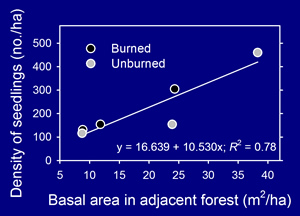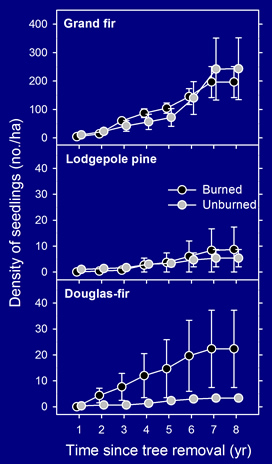Bunchgrass
Ridge![]()
Ecology and restoration
of conifer-invaded meadows:![]()
Research and adaptive management![]()
![]()
| Home > Research > 4. Restoration experiment > Recent results: Conifer reinvasion |
| Recent results: Conifer reinvasion of restoration treatments |
| Home | |||||||||||||||||||||||||||||
| Study area | |||||||||||||||||||||||||||||
| Research | |||||||||||||||||||||||||||||
|
|||||||||||||||||||||||||||||
| Education | |||||||||||||||||||||||||||||
| Outreach | |||||||||||||||||||||||||||||
| Products | |||||||||||||||||||||||||||||
| Participants | |||||||||||||||||||||||||||||
| Key findings | |||||||||||||||||||||||||||||
|
| Results | |||||||
| Seedlings established continuously after tree removal, but density did not differ between treatments (see figures at right). Late-seral grand fir was dominant; lodgepole pine and Douglas-fir were far less abundant. Density declined steeply with distance from edge in many plots (see seedling density maps, below left); local density in the 5-m outer band averaged 682 seedlings/ha vs. 140 seedlings/ha in the remainder of the plot. Grand fir seedlings were more abundant along S than along N edges (see upper figure, below right). Plot-level density of grand fir seedlings correlated strongly with basal area of grand fir in the adjacent forest (but not with its density or height) (see lower
Conclusions Despite low density of seedlings after 8 years, continuous establishment over time suggests the need for periodic re-entry and removal of seedlings. Fortunately, slow-growing grand fir remains small and can be cut efficiently with hand tools. Spatial patterns of seedling establishment indicate strong influences of adjacent forests on the reinvasion process. Positive associations with forest edge, shaded N-facing exposures, and tree size (basal area) suggest that removal treatments should be configured to minimize edge effects and to maximize distances to seed sources (particularly larger trees). Absence of a treatment effect suggests that burning—critical for reducing woody residues following tree removal—does not increase the probability of seedling establishment, at least where late-seral species such as grand fir are the principal colonists. |
|
||||||




